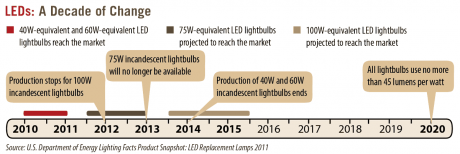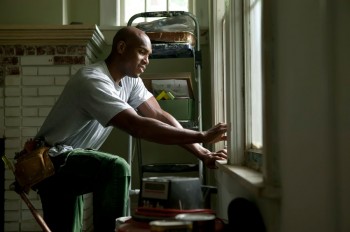Solid lighting solutions
LEDs meet (and exceed) 2014 lighting efficiency standards
By Megan McKoy-Noe, CCC, and Brian SlobodaThe year 2014 has ushered in updated lightbulb efficiency guidelines. Congress called for improved energy efficiency standards for traditional incandescent bulbs under the federal Energy Independence and Security Act of 2007. By 2014, light bulbs using between 40 watts and 100 watts had to consume at least 28 percent less energy than classic bulbs. The change is projected to save Americans an estimated $6 billion to $10 billion in lighting costs annually. The new wave of standards means traditional 40-watt and 60-watt incandescents are no longer produced.
Some consumers are turning to LEDs (light-emitting diodes).
Solid-state lighting
Incandescent bulbs’ thin wires (filaments) can easily break, as frustrated homeowners can attest. In contrast, LEDs are solid-state lighting — small, packed electronic chip devices. Two conductive materials are placed together on a chip (a diode). Electricity passes through the diode, releasing energy in the form of light.
Measuring LED potential
The Cooperative Research Network of the National Rural Electric Cooperative Association has partnered with several electric cooperatives in the U.S. to test LEDs. Researchers are cautiously optimistic that:
- LEDs last longer, perhaps for decades.
- The energy to use LEDs could be substantially less than that of compact fluorescent lamps (CFLs) or other fluorescents.
- With no mercury content, LEDs are more environmentally friendly than CFLs.
- LEDs perform well in cold climates, especially outdoors.
- LEDs can be dimmed and produce a more pleasing light.
Buyer beware
Poor quality LED products are flooding the marketplace. Some are manufactured outside of the U.S. with components that produce low light levels. These also don’t have a long service life and may carry exaggerated claims.
Look for the U.S. Department of Energy’s Energy Star logo for guaranteed color quality over time, steady light output over the lifetime, high efficiency and a warranty. Also look for an LED Lighting Facts label. It helps consumers compare products to manufacturer claims and similar products in these five areas:
- Lumens: Measures light output. The higher the number, the more light is emitted.
- Lumens per watt: Measures efficiency. The higher the number, the more efficient the product.
- Watts: Measures the energy required to light the product. The lower the wattage, the less energy is used.
- Correlated Color Temperature (CCT): Measures light color. “Cool” colors have higher Kelvin temperatures (3,600 to 5,500 K); “warm” colors have lower color temperatures (2,700 to 3,000 K). Cool white light is usually better for visual tasks. Warm white light is usually better for living spaces because it casts a warmer light on skin and clothing. Color temperatures of 2,700 to 3,600 K are recommended for most general indoor and task lighting.
- Color Rendering Index (CRI): Measures the effect of the lamp’s light spectrum on the color appearance of objects. The higher the number, the truer the appearance of the light. Incandescent lighting is 100 on the CRI.
Learn & compare
Some consumers avoid LEDs because of the price tag. But it takes about 50 traditional incandescent bulbs, or eight to 10 CFLs, to last as long as one LED lamp. Curious to know if LEDs are right for you? Visit energysavers.gov/lighting to compare LEDs to new energy-efficient incandescent bulbs and CFLs.
About the Author
Megan McKoy-Noe, CCC, writes on consumer and cooperative affairs for the National Rural Electric Cooperative Association, the service organization for the nation’s 900-plus consumer-owned, not-for-profit electric cooperatives.Brian Sloboda is a program manager specializing in energy efficiency for the Cooperative Research Network, a service of the National Rural Electric Cooperative Association.
-
Share this story:




